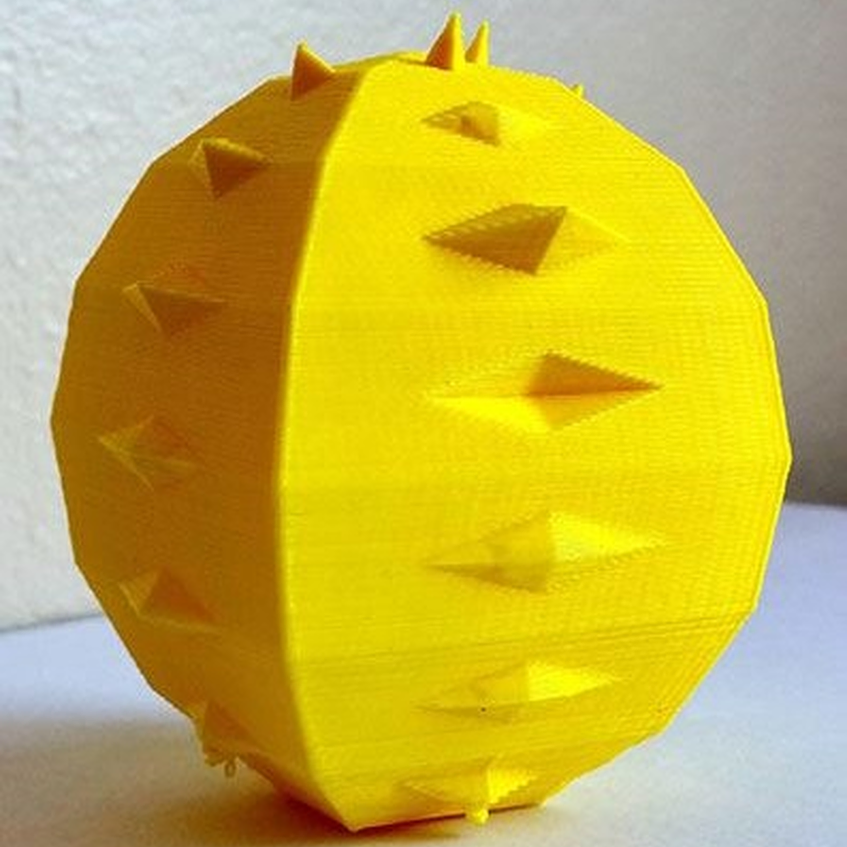אמנות לסוכרת - פסלי 3D לרמות הסוכר בדם

ג'וסטוס האריס (Justus Harris) האמן, נקט בגישה חדשנית עם הסוכרת נעורים שלו (מגיל 14). הוא נהיה אמן ויזואלי טכנולוגי המייצר פסלי 3D מדהימים מנתוני הגלוקוז בדם שלו ועוד נתוני בריאות.
הוא מאמין שביטוי ויזואלי כזה של נתוני בריאות, יכול להפוך לנורמה חדשה ובלתי מתחמקת בהתמודדות עם מחלות כרוניות והצגת נתונים.
אחרי השלמת לימודי האמנות רצה ג'וסטוס להפנות תשומת לב לרפואה דרך הסוכרת 1 שלו והתנדב להשתתף במחקרי סוכרת באוניברסיטת אילינוי ובאוניברסיטת שיקגו.
כיום, בגיל 42 הוא גם מורה לאמנות וגם משתתף במחקר באוניברסיטת סטנפורד על הלבלב המלאכותי Bionic Pancreas לסוכרתיים ויש לו הרבה הארות/הערות.
הרעיון לפסלים הגיע כשראה איך הרופאה מאוניברסיטת שיקגו Dr. Elizabeth Littlejohn מעבדת את נתוני בריאותו וכתגובה הוא תכנן הדפסי 3D מוחשיים המייצגים יומן בריאות. הפסלים ייצגו בפשטות את המדדים החודשיים של רמות הגלוקוז, כמויות האינסולין ומידת הפחמימות שנאכלו וזאת דרך צורה ומרקם שייצגו ברצף שינויי בריאות. זה איפשר ל"הרגיש" את הפסל ולהבין את הבריאות האישית הרבה יותר נכון מאשר מהתבוננות בנתוני רפואה.
הפסל תוכנן לייצג זמן (למשל, מעגל כחודש, רבע ממנו כשבוע, ו7- חלקים בכל רבע לכל יום), לייצג רמות סוכר בדם על פי צבע (למשל, רמות סוכר 100-140 כירוק או 141-170 כצהוב, או אוסף צבעים לרמות גבוהות שמעל 171) או גובה בליטות או שקעים על פני השטח כמייצג את גובה רמות הסוכר או רמות האינסולין. לא קשה להעריך A1C מהתבוננות מהירה בפסל כזה שכמובן כל אחד יכול להתאים עצמו על פי נתוניו.
צורות הפסלים מעוגלות אבל נועדו להתאים לתפיסה ומישוש בכף היד ולכן אינם גדולים.
ייקח זמן עד שרופאים יתרגלו להשתמש עם המטופלים במידע כזה בצורה כזאת (ראו מאמר של ד"ר אהרון נינשטיין) ואני מניחה שיהיו אלה הילדים המתוחכמים ביננו שיעשו את זה ראשונים...
בינתיים מנסה ג'וסטוס לקדם את השימוש בטכנולוגית פסלי 3D לסוכרתיים בעזרת Tidepool ומתנדבים סוכרתיים ואנחנו מחכים לראות גם איך יתנהל ה- DiabetesMine D-Data ExChange
לא בכדי הכתירו את ג'וסטוס האריס כמלך...
הנה תגבותו של ג'וסטוס לאימייל שכתבתי לו, ונכונותו לשלב גם סוכרתיים מ"כמוני":
,Dear Dina
.Thank you again for reaching out and translating the article
One could certainly add data to the sculptures form other fields, which you have mentioned.
:The consideration so far in choosing data have been
1) What is most clinically recognized in relation to health for diabetes such as blood glucose readings and times patient tests blood glucose, time a patient is in target glucose range.
2) What data is consistently recorded by patients and is accessible, the above examples - blood glucose, testing adherence, and time in target range are all able to be taken from a continuous glucose monitor (CGM) and an Insulin pump.
Thus far, these two considerations with data sets, clinical significance and high frequency of consistent monitoring by patients, have been the starting point.
Of course many other measurements and correlations to health and well-being exist but they must be consistently recorded in order to be used for a sculpture.
This, however, is an opportunity to provide people with a new incentives to record things such as how many friends they talked to in a day, finances, etc. in a way where the data will be more understandable and tangible, and thus for many, more desirable.
Presently, the sculptures are being created on a small scale for around ten individuals with likely implementation in clinical trials for pediatric type 1 diabetics next year. The base cost is highly variable as 3D printing is constantly changing, mostly becoming lower in cost and the labor to create them is high as there is not a program for automating how the data is translated into the sculptural form yet. It is feasible that the cost could be USD $50 per sculpture, or far less in the near future with a goal to have insurance cover part of the cost.
It would be great to expand the project to Israel and I would welcome participation there . We could discuss a partnership with your institution. I would like to learn more about CAMONI and the Gertner Institute's goals from you as I have had some time to look up different departments such as Patient Empowerment and Technology Assessment in Healthcare online.
I appreciate your questions and would look forward to following up with you soon. I will be presenting the Health Data Sculptures at Stanford Nov 19th and have been talking with several 3D printing companies so there is considerable movement on this project.
The Very Best,
Justus Harris
[email protected]
תגובות



vespa47
אז איפה כל הפרמטרים האחרים שאנשים טוענים כמשפיעים על סכרת ??
חלב ומוצריו?!
סיבים?
שומנים?
ויש לי עוד כמה ברשימה...
נכון שהדמיות דו/ או תלת ממדיות עשויות לשפר מצב רוחם של רופאים ופאצינטים. אבל כל מחשב יוכל לעשות ניתוח של הנתונים בשלוש שניות כשהרופאים עדיין רושמים את שמו הפרטי של החולה...
ד"ר דינה ראלט PhD
כתבתי לשאול את ג'וסטוס על זה אבל הוא טרם ענה לי...
ד"ר דינה ראלט PhD
בינתיים, נהלו את המצב הסוכרתי בעזרת האפליקציה החינמית לסמארטפון - SuCare
http://www.camoni.co.il/index.php?idr=400&p=210851
vespa47
חכם אחד גרס כי יש לנו ארבעה ממדים
אורך, רוחב, גובה ו- זמן
חושבני שצריך להכניס זאת לענין!
ד"ר דינה ראלט PhD
הרצאה של ג'וסטוס הריס
https://youtu.be/QwJkMVltRLs
ד"ר דינה ראלט PhD
במוזאון ב- 2020 https://www.elsewheremuseum.org/projects/proposal-2-justus-harris
ד"ר דינה ראלט PhD
גם בפייסבוק - https://www.facebook.com/justus.harris.1